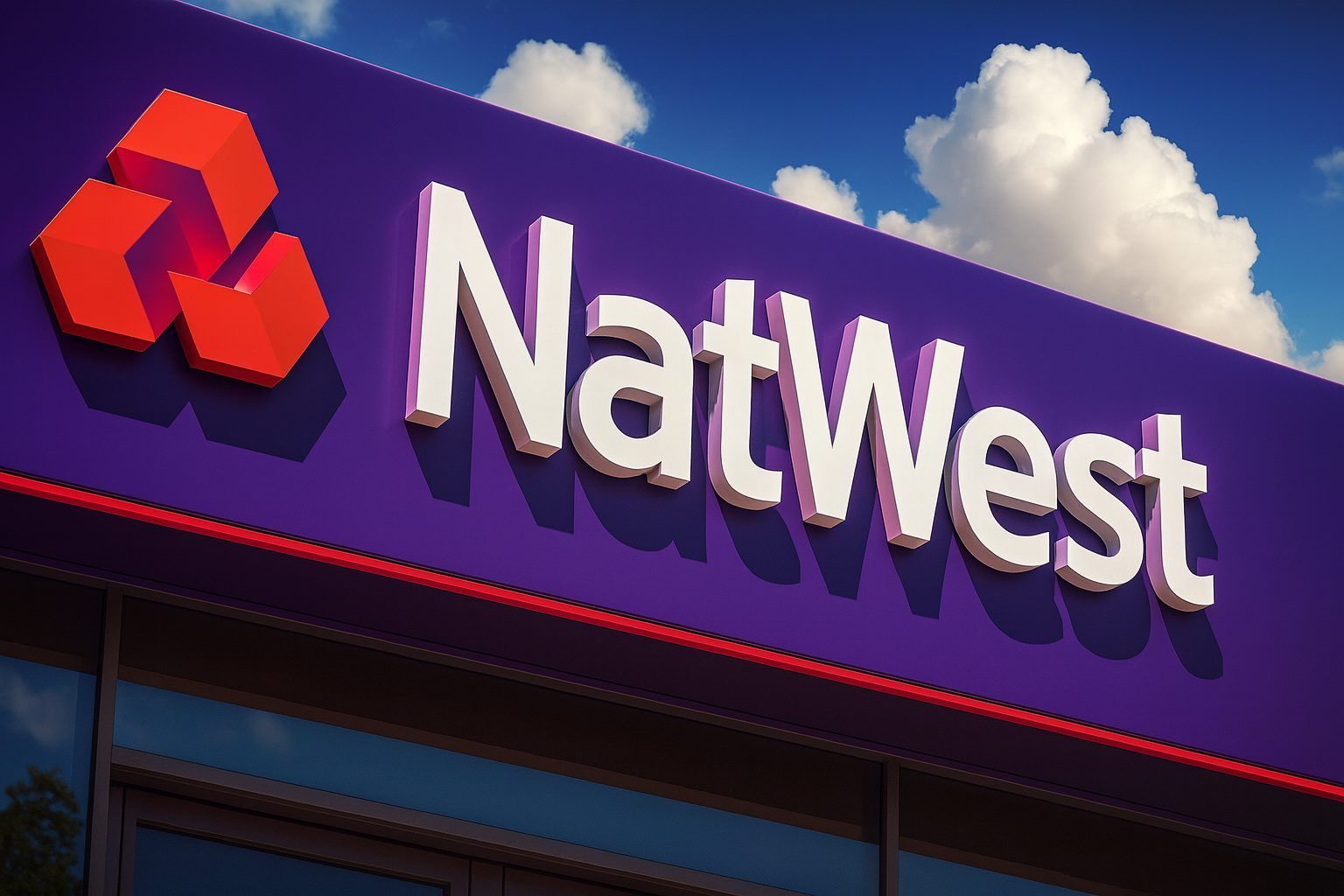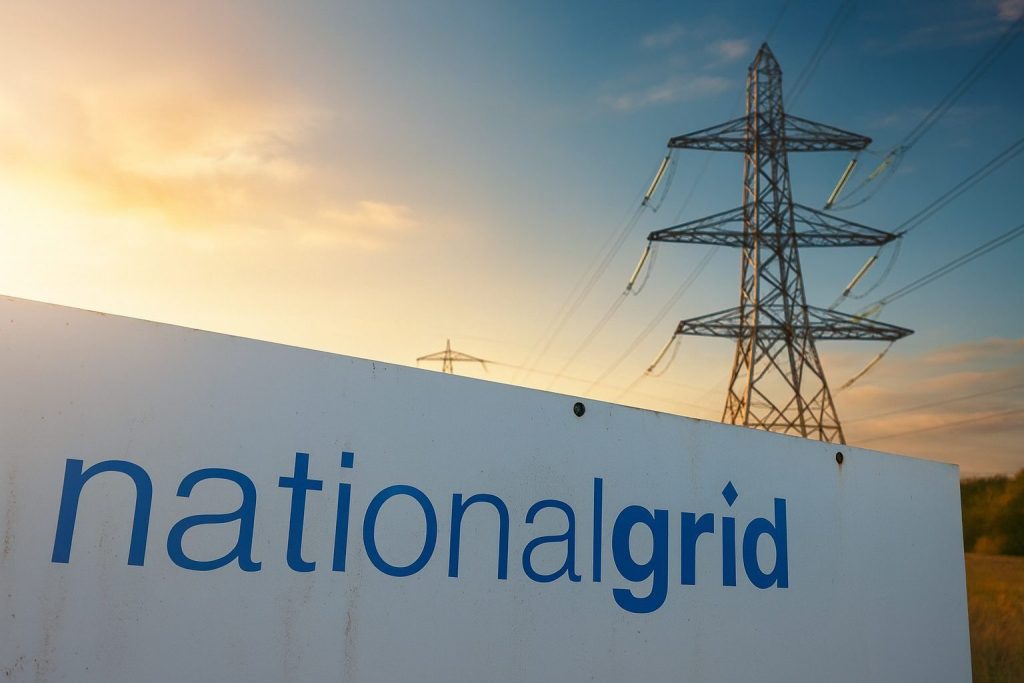On Wednesday 26 November 2025, NatWest Group plc (LON: NWG; NYSE: NWG) is trading slightly lower after a strong rally into Chancellor Rachel Reeves’ first Labour Budget, as investors weigh a fresh share buyback disclosure, new investor materials on its retail bank and a regulatory filing revealing a bigger stake in Microsoft. [1]
NatWest today at a glance
- Share price: Around 597.8p in London, down just over 1% intraday from Tuesday’s close of 604.8p, after a 3.7% jump the previous session. The stock has traded between about 597.6p and 615.4p today and sits close to its 52‑week high near 626.6p. [2]
- Budget outcome: Rachel Reeves’ Autumn Budget appears not to include a new bank‑specific tax, easing a long‑running overhang for the sector. NatWest and Lloyds were recently down about 0.8% intraday as traders locked in profits after the news. [3]
- Capital returns: A new Form 6‑K shows NatWest repurchased 880,354 shares on 25 November at an average price of roughly 600.8p, with all shares earmarked for cancellation under its ongoing buyback programme. [4]
- Portfolio move: U.S. regulatory data indicate NatWest increased its holding in Microsoft by 31.7% in Q2 to 43,758 shares, making the software giant the largest position in the portfolio covered by the filing (worth about $21.8m at the time). [5]
- Strategy update: A new Retail Banking Investor Spotlight deck highlights a mortgage‑heavy loan book (around 92% of retail loans) with low loan‑to‑value ratios and very low impairments, supporting management’s 2025 target of >18% return on tangible equity (RoTE). [6]
1. NatWest share price: holding near highs as Budget lands
After years of restructuring, NatWest has been one of the standout performers in the UK banking sector during 2025. Third‑quarter results in October showed a 30% jump in pretax operating profit to about £2.2bn, beating expectations and prompting management to raise this year’s RoTE target from “above 16.5%” to above 18%. Shares briefly hit levels last seen in the late 2000s on the news. [7]
That momentum continued into late November. On Tuesday 25 November the London‑listed stock closed at 604.8p, up 3.74% on the day, as markets bet that Reeves would stop short of a fresh levy on banks in her first Budget. [8]
Today the pattern looks more like “buy the rumour, trim on the fact”:
- Current price: ~597.8p
- Change vs Tuesday close: just over ‑1%
- Intraday range: roughly 597.6–615.4p
- 52‑week range: about 369–626.6p [9]
Even after today’s wobble, NatWest’s shares remain close to their one‑year high and well above the roughly 380–400p levels seen last autumn, reflecting improved profitability, a cleaner balance sheet and ongoing share buybacks.
2. Budget relief: no new bank levy (for now)
For months, UK bank stocks have traded with one eye on the prospect of a “tax raid” to help fill the government’s fiscal gap. A widely discussed proposal was a levy on interest income that banks earn on reserves held at the Bank of England – a move that would have hit lenders such as NatWest particularly hard. [10]
Today’s headlines suggest those fears have, at least temporarily, been put to bed:
- A document from the Office for Budget Responsibility released alongside the Budget made no reference to higher taxes specifically targeted at banks. [11]
- Reuters reports that shares in domestic lenders Lloyds and NatWest slipped around 0.8% during trading as earlier gains were consolidated, while more globally diversified peers like HSBC and Barclays edged higher. [12]
- A Guardian live blog yesterday noted that banks were among the main risers on Budget‑eve, helping push the FTSE 100 up about 0.8%, after reports they would avoid a windfall tax. [13]
For NatWest, the absence of a new levy is meaningful. Management is already targeting one of the highest RoTE levels among large European banks – north of 18% for 2025 – relying on a combination of loan growth, tight cost control and relatively low impairment charges. Extra taxes would have eaten directly into those returns. [14]
Of course, “no new tax today” doesn’t guarantee the sector is off the hook forever. The same Reuters piece flags that the idea of tapping bank profits remains politically attractive in some quarters, so investors will continue to track fiscal debates closely. [15]
3. Fresh share buyback: shrinking the share count
Alongside the macro news, NatWest quietly filed another update on its ongoing share repurchase scheme.
According to a Form 6‑K lodged with the U.S. Securities and Exchange Commission, the bank:
- Bought back 880,354 ordinary shares on 25 November 2025.
- Paid a high of 605.6p, a low of 589.2p and a volume‑weighted average price of 600.79p.
- Conducted the purchases on the London Stock Exchange via Merrill Lynch International.
- Plans to cancel all of these shares, rather than hold them for employee schemes, reducing the number of shares in circulation. [16]
After settlement, NatWest will hold roughly 230.2m shares in treasury and have about 8.02bn shares in issue (excluding treasury stock). [17]
This is only the latest in a long line of daily buyback notices through October and November, all part of a programme originally announced in late July. Combined with generous ordinary dividends – the group aims to distribute around 50% of attributable profit via dividends from 2025 onwards – these repurchases are a key plank in the bank’s capital‑return story. [18]
For shareholders, cancelling shares has two main effects:
- Boosts per‑share metrics (earnings, tangible net asset value) if profits remain stable.
- Signals management confidence that the stock is undervalued relative to its long‑term prospects.
4. Retail Banking spotlight: mortgages, low LTVs and stable deposits
NatWest this week published a detailed “Retail Banking – Investor Spotlight” presentation, giving more colour on the engine room of its earnings. [19]
Key takeaways from the slides include:
- The retail loan book totals around £218bn, of which roughly 92% are mortgages.
- Around 92% of those mortgages are on fixed rates, reducing immediate sensitivity to changes in Bank of England base rates.
- The average loan‑to‑value ratio is about 56%, giving a decent cushion against house‑price volatility.
- Retail credit quality remains strong: management shows very low average impairment charges on mortgages since 2021 and only modest arrears in unsecured lending. [20]
- Unsecured lending (personal loans and cards) makes up about 8% of retail balances and carries higher, but still manageable, loss rates. [21]
- Retail loans have grown at around 5% compound annual growth in recent years, lifting the loan‑to‑deposit ratio from the mid‑90s to roughly 110% by Q3 2025. [22]
The presentation also underlines a refreshed management line‑up:
- Solange Chamberlain became CEO of Retail Banking in July 2025 after previously leading strategic development and the bank’s climate and sustainable banking agenda.
- CEO Paul Thwaite, in post since 2023, brings three decades of experience across wholesale and retail banking. [23]
For investors worried about UK housing risk, the emphasis on low LTVs, fixed‑rate loans and small unsecured exposure is designed to reassure that NatWest’s retail book can absorb a reasonable amount of macro stress.
5. Portfolio tilt: bigger bet on Microsoft
Away from its core lending activities, NatWest’s name popped up in a U.S. filing covering institutional holdings of Microsoft (NASDAQ: MSFT).
According to analysis published by MarketBeat:
- NatWest boosted its Microsoft stake by 31.7% in Q2.
- The bank now owns 43,758 Microsoft shares, after buying an extra 10,545 shares.
- At the time of the filing, the position was valued at roughly $21.8m and represented about 6.4% of the portfolio being reported, making Microsoft its largest single holding in that context. [24]
For a group with total assets well over £400bn, this is immaterial to NatWest’s capital strength, but it illustrates how the bank’s treasury and asset‑management arms are leaning into large‑cap technology as a source of diversified returns. The filing sits alongside Microsoft’s own strong earnings update – the tech giant recently beat expectations on both revenue and EPS and raised its dividend. [25]
Investors should remember that such positions typically sit in investment portfolios rather than the core UK retail and commercial banking balance sheet.
6. How the market now values NatWest Group
Recent research notes paint a picture of cautious optimism around NatWest’s valuation:
- A DirectorsTalk roundup on 24 November put the share price at about 579p, with a 52‑week range of 374–624p, revenue growth near 19%, earnings per share around 0.64 and return on equity close to 13.9%. The piece highlighted a trailing dividend yield of roughly 4.3% and a payout ratio near 39%. [26]
- The same note summarised analyst sentiment as 12 “buy”, 4 “hold” and 1 “sell” rating, with an average target price around 645p, implying roughly 11% upside from the then share price. [27]
- A separate valuation site, Eulerpool, quotes an average target of about 653p, also implying low‑double‑digit upside versus current levels, and a forward dividend of roughly 43p per share, which would equate to a yield of around 7% if delivered. [28]
- At the more bullish end, a Peter‑Lynch‑style model on ValueInvesting.io estimates a “fair value” above £16 per share – more than double today’s price – but such models rely heavily on assumptions about growth and multiples and are best treated as one input among many. [29]
- On the other side of the debate, a Morningstar commentary in late October said it had raised its fair value estimate again and upgraded NatWest’s economic moat rating to “narrow”, but still considered the stock moderately overvalued after the post‑earnings rally. [30]
In short, consensus still leans positive, but with less “deep value” than earlier in the year. Total return potential now depends heavily on whether NatWest can sustain elevated returns on equity and keep credit losses low as rates eventually start to fall.
7. Reputation and regulation: court wins and legacy issues
2025 has also been a year of clearing the decks on reputational fronts.
- In March, NatWest and Brexit campaigner Nigel Farage reached a confidential settlement over the closure of his accounts at private bank Coutts, ending a politically charged dispute that had already cost the group its former CEO Alison Rose and prompted a regulatory review and proposed new rules on how banks close customer accounts. [31]
- This week, The Times reported that a Scottish appeal court dismissed a case brought by a customer who said a NatWest branch’s Pride display triggered a “phobia” and breached his rights under the Equality Act. The court reportedly criticised the legal arguments – including references to fictitious case law attributed to AI tools – and ordered the claimant to pay NatWest’s costs. The bank welcomed the ruling. [32]
These episodes underscore the scrutiny UK banks face on how they treat customers and promote inclusion. Regulators have already floated rules forcing banks to provide clearer reasons and longer notice periods before “debanking” clients, a framework that will shape how NatWest manages reputational risk in the years ahead. [33]
8. What to watch after 26 November 2025
Looking beyond today’s headlines, here are the key catalysts that could shape NatWest’s next moves:
- Full‑year 2025 results (13 February 2026): Management has flagged that it will introduce 2026 guidance and new 2028 targets alongside the full‑year numbers, which will be crucial for assessing how sustainable current returns are. [34]
- Interest‑rate trajectory: NatWest’s net interest margin has been edging higher, supported by its structural hedge, but Bank of England rate cuts in 2026 would eventually squeeze this tailwind. [35]
- Credit quality in UK households and SMEs: With a heavily mortgage‑weighted book, investors will keep an eye on arrears and impairments, especially in unsecured lending and buy‑to‑let segments. The investor spotlight suggests management is comfortable for now, but macro conditions can change quickly. [36]
- Further government stake sales and liquidity in the stock: The UK state has already exited its role as the largest shareholder after successive disposals, and NatWest is now fully back in private hands – a symbolic milestone that could broaden its investor base over time. [37]
- Regulatory moves on bank taxation: Today’s Budget seems to have spared banks from specific new levies, but calls for windfall taxes resurface frequently in UK politics. Future Budgets and consultations will remain a risk factor. [38]
Bottom line
As of 26 November 2025, NatWest Group is trading close to multi‑year highs, supported by strong Q3 profits, ambitious return targets and aggressive capital returns, while today’s Budget appears to have removed – at least for now – the threat of an immediate new bank tax. At the same time, much of the recovery story is now reflected in the share price, leaving investors to debate how much upside remains as the cycle matures.
This article is for information only and does not constitute investment advice. Anyone considering buying or selling NatWest Group shares should conduct their own research or consult a regulated financial adviser.
References
1. www.investing.com, 2. www.investing.com, 3. www.reuters.com, 4. www.stocktitan.net, 5. www.marketbeat.com, 6. investors.natwestgroup.com, 7. www.reuters.com, 8. finance.yahoo.com, 9. www.investing.com, 10. www.reuters.com, 11. www.reuters.com, 12. www.reuters.com, 13. www.theguardian.com, 14. www.reuters.com, 15. www.reuters.com, 16. www.stocktitan.net, 17. www.stocktitan.net, 18. investors.natwestgroup.com, 19. investors.natwestgroup.com, 20. investors.natwestgroup.com, 21. investors.natwestgroup.com, 22. investors.natwestgroup.com, 23. investors.natwestgroup.com, 24. www.marketbeat.com, 25. www.marketbeat.com, 26. www.directorstalkinterviews.com, 27. www.directorstalkinterviews.com, 28. eulerpool.com, 29. valueinvesting.io, 30. global.morningstar.com, 31. www.reuters.com, 32. www.thetimes.com, 33. www.reuters.com, 34. investors.natwestgroup.com, 35. investors.natwestgroup.com, 36. investors.natwestgroup.com, 37. www.reuters.com, 38. www.reuters.com







